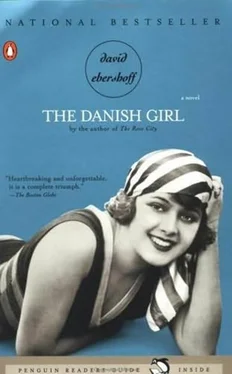With the spring of 1931 came the contracting markets and the plummeting currencies and a general black cloud of ruin, economic and otherwise. Americans began to sail away from Europe, Greta read in the newspapers; she saw one booking air-and-sea passage at the Deutscher Aero-Lloyd office, a woman with a beaver collar and a child on her hip. A painting, even a good one, could hang on the wall of a gallery and remain unsold. It was a drab world for Lili to emerge into; it wasn’t the same world.
Each morning Greta would nudge Lili, who sometimes couldn’t wake on her own. Greta would pull a skirt from the hanger, and a blouse with wooden buttons, and a sweater with wrists patterned with snowflakes. She would help Lili dress, and serve her coffee and black bread and smoked salmon sprinkled with dill. Only by mid-morning would Lili become fully alert, her eyes blinking back the morphine, her mouth dry. “I must have been tired,” she would say apologetically, and Greta would nod and answer, “There’s nothing wrong with that.”
When Lili was out on her own-either shopping at the Gammel Strand fish market or at the pottery class Greta enrolled her in-Greta would try to paint. Only six years had passed, but it seemed longer since she had last lived in the apartment with its ghostly smell of herring. Some things were the same: there were the horns of the ferries bound for Sweden and Bornholm, and the afternoon light, which sliced through the windows just before the sun dipped beyond the city, silhouetting the needles of the church spires. Standing at her easel, Greta would think about Einar then and Lili today, and Greta would shut her eyes and hear a tinkling bell of memory in her head but then recognize it as the ping! of the Cantonese laundress who was still calling from the street. She regretted nothing, Greta believed.
The king granted their divorce with a speed that alarmed her. Of course they could no longer live as man and wife, now that they were both women and Einar lay in memory’s coffin. Even so, the officials, who wore black bow ties and whose fingers shook nervously, surprised Greta when they filed the paperwork with an uncharacteristic alacrity. She had expected-even counted on-a bureaucratic delay; she nearly imagined the request lost in an accordion file. Although she didn’t like to admit it, she was like many young women from Pasadena who thought of divorce as a sign of moral flaccidness; or, more specifically, Greta thought of it as a sign of lacking a Western spine. She found herself unusually concerned about what others might think and say about her-as if she were so frivolous and weak-minded that she had simply married the wrong man. No, Greta didn’t like to think of herself that way. She pressed for a death certificate for Einar Wegener, which no one in any position of authority agreed to, although everyone in the bureau knew of the nature of her case. There was one official, whose nose was long and wore the twitch of a white mustache just beneath it, who conceded that it was closest to the truth. “I’m afraid I can’t rewrite the law,” he said, a stack of papers nearly reaching his mustache. “But my husband is dead,” Greta tried, her fists landing on the counters that separated her from the room of bureaucrats, with their sleeve bands and their abaci and their yellow smell of tobacco and pencil shavings. “He should be declared dead,” she tried on her last visit to the government office, her voice softening. Above the room of bureaucrats, watching them, was one of her early paintings: Herr Ole Skram in a black suit, vice-minister in the king’s government for less than a month, noted only for his remarkable and well-witnessed death in the tangled tether of a hot-air balloon. But Greta’s pleas failed. And so Einar Wegener officially disappeared, grave-less and gone.
“She needs to lead her own life,” Hans said one day. “She should get out on her own and make her own friends.”
“I’m not stopping her from doing that.” Greta had run into him at the entrance of the Royal Academy of Arts, under the arch. It was April, and the wind was easterly, chilled and salted from the Baltic. Greta turned up her collar against the wind. Students in sawed-off gloves were passing by. “And you, too,” he said.
Greta said nothing, the chill creeping down her spine. She could see out into Kongens Nytorv. In front of the statue of King Christian V, a boy with a blue scarf dangling to his knees was kissing a girl. The thing about Hans was this: he always reminded her of what she didn’t have; of what she’d convinced herself-when she sat in her reading chair waiting for Lili to return, her heart quickening at every false sound in the stairwell-she could go without. What was she afraid of?
“How about driving up to Helsingør with me tomorrow?” he proposed.
“I don’t think I can get away,” she said. The wind picked up, hurtling through the academy’s portico, where the walls were scraped from lorries too wide to pass. Greta and Hans went inside, into one of the side halls, where the plank floors were unvarnished and the walls painted a soft soap-green and the banister running up the staircase was white.
“When will you realize she’s no longer yours?”
“I never said she was.” And then, “I was talking about my work. It isn’t easy to take even a day off from my work.”
“How would you know?”
She felt a sudden loss, as if the cruelty of progress and time had just then grabbed from her her days as a student at the academy; as if her past had remained hers until today. “Einar’s dead,” she heard herself say.
“But Lili isn’t.” He was right. After all, there was Lili, probably this very minute sweeping the apartment, her face caught in a windowpane of sun. Lili with her pretty bony wrists and her eyes nearly black. Just yesterday she had said, “I was thinking about taking a job.”
“Don’t you see I’m a little sad?” Greta said.
“Don’t you see that I want you to tell me that?”
“Hans,” she said. “Maybe I should go.” It was then that Greta realized they were at the foot of the steps where she and Einar had first kissed, and fell in love. The white balustrades and the plank steps worn from decades of tardy students with incomplete assignments shoved up beneath their arms. The paned windows were hooked against the cold. The hall was quiet; no one was around. Where had all the students gone? Greta heard a door somewhere catch in its latch. Then everything fell silent again, and something imperceptible passed from Hans to her, and out the window, in the courtyard, in the long shadow of the academy, the boy with the blue scarf kissed his girl, again and again, and yet again.

Lili was sitting in the rope-bottom chair, wondering if now was the right time to tell Greta. Lili could see through the window the masts of the herring boats on the canal. Behind her, Greta was painting a portrait of Lili’s back. Greta said nothing as she outlined the painting, and Lili heard only Greta’s bracelets tinkling. Smoldering in the pit of her groin was the leftover pain, so steady that more and more Lili had taught herself to ignore it; the inside of her lip was shredded from biting down. Professor Bolk had promised it would eventually go away.
She thought of the girls at the clinic. The day before Professor Bolk released Lili, they threw her a party in the garden. Two girls pulled a white cast-iron table onto the lawn, a third carried from her room a primrose in a cachepot painted with bunnies. The girls tried to spread a yellow cloth across the table, but the wind was keeping it aloft. Lili sat at the head of the table, on a cold metal chair, watching the cloth fluttering as the girls tried to tie down its corners. The sunlight poured through the yellow cloth, filling Lili’s eyes, the cachepot in her lap.
Читать дальше













